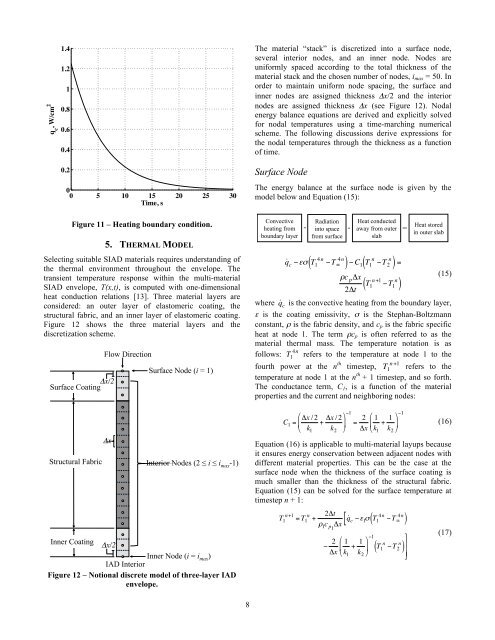Thermal, Structural, and Inflation Modeling of an Isotensoid ...
Thermal, Structural, and Inflation Modeling of an Isotensoid ...
Thermal, Structural, and Inflation Modeling of an Isotensoid ...
You also want an ePaper? Increase the reach of your titles
YUMPU automatically turns print PDFs into web optimized ePapers that Google loves.
q c<br />
, W/cm 2<br />
1.4<br />
1.2<br />
1<br />
0.8<br />
0.6<br />
0.4<br />
0.2<br />
0<br />
0 5 10 15 20 25 30<br />
Time, s<br />
The material “stack” is discretized into a surface node,<br />
several interior nodes, <strong><strong>an</strong>d</strong> <strong>an</strong> inner node. Nodes are<br />
uniformly spaced according to the total thickness <strong>of</strong> the<br />
material stack <strong><strong>an</strong>d</strong> the chosen number <strong>of</strong> nodes, i max = 50. In<br />
order to maintain uniform node spacing, the surface <strong><strong>an</strong>d</strong><br />
inner nodes are assigned thickness Δx/2 <strong><strong>an</strong>d</strong> the interior<br />
nodes are assigned thickness Δx (see Figure 12). Nodal<br />
energy bal<strong>an</strong>ce equations are derived <strong><strong>an</strong>d</strong> explicitly solved<br />
for nodal temperatures using a time-marching numerical<br />
scheme. The following discussions derive expressions for<br />
the nodal temperatures through the thickness as a function<br />
<strong>of</strong> time.<br />
Surface Node<br />
The energy bal<strong>an</strong>ce at the surface node is given by the<br />
model below <strong><strong>an</strong>d</strong> Equation (15):<br />
Figure 11 – Heating boundary condition.<br />
5. THERMAL MODEL<br />
Selecting suitable SIAD materials requires underst<strong><strong>an</strong>d</strong>ing <strong>of</strong><br />
the thermal environment throughout the envelope. The<br />
tr<strong>an</strong>sient temperature response within the multi-material<br />
SIAD envelope, T(x,t), is computed with one-dimensional<br />
heat conduction relations [13]. Three material layers are<br />
considered: <strong>an</strong> outer layer <strong>of</strong> elastomeric coating, the<br />
structural fabric, <strong><strong>an</strong>d</strong> <strong>an</strong> inner layer <strong>of</strong> elastomeric coating.<br />
Figure 12 shows the three material layers <strong><strong>an</strong>d</strong> the<br />
discretization scheme.<br />
!x/2!<br />
Surface Coating<br />
<strong>Structural</strong> Fabric<br />
Flow Direction<br />
!x!<br />
Surface Node (i = 1)<br />
Interior Nodes (2 ! i ! i max -1)<br />
Inner Coating<br />
!x/2!<br />
Inner Node (i = i max )<br />
IAD Interior<br />
Figure 12 – Notional discrete model <strong>of</strong> three-layer IAD<br />
envelope.<br />
where q ˙ c is the convective heating from the boundary layer,<br />
ε is the coating emissivity, σ is the Steph<strong>an</strong>-Boltzm<strong>an</strong>n<br />
! const<strong>an</strong>t, ρ is the fabric density, <strong><strong>an</strong>d</strong> c p is the fabric specific<br />
!<br />
heat Convective at node 1. The Radiation term ρc p Heat is <strong>of</strong>ten conducted referred to as the<br />
material heating from thermal -<br />
Heat stored<br />
into mass. space The - away temperature from outer notation =<br />
in outer is slab as<br />
boundary layer from surface slab<br />
follows: refers to the temperature at node 1 to the<br />
!<br />
8<br />
Convective<br />
heating from<br />
boundary layer<br />
Energy added<br />
to slab i over<br />
time !t<br />
q ˙ c "#$ T 4n 4n<br />
( 1 "T % ) " C 1 T n n<br />
( 1 "T 2 ) =<br />
T 1 4n<br />
&c p 'x<br />
n<br />
T +1 n<br />
Energy<br />
( 1 "T 1 )<br />
tr<strong>an</strong>sferred 2't -<br />
T 1<br />
n +1<br />
(15)<br />
fourth power at the n th timestep, refers to the<br />
temperature at node 1 at the n th + 1 timestep, <strong><strong>an</strong>d</strong> so forth.<br />
Convective Radiation Heat conducted<br />
The<br />
!<br />
conduct<strong>an</strong>ce term, C 1 , is a function <strong>of</strong> the material<br />
heating from -<br />
Heat stored<br />
into space - away from outer =<br />
properties boundary layer <strong><strong>an</strong>d</strong> the from current surface <strong><strong>an</strong>d</strong> neighboring slab nodes: in outer slab<br />
!<br />
#<br />
C 1 = %<br />
$<br />
Radiation<br />
into space<br />
from surface<br />
"x /2<br />
k 1<br />
+<br />
"x /2<br />
k 2<br />
&<br />
(<br />
'<br />
)1<br />
= 2 # 1<br />
+ 1 &<br />
% (<br />
"x $ k 1 k 2 '<br />
Equation (16) is applicable to multi-material layups because<br />
it ensures energy conservation between adjacent nodes with<br />
! different material properties. This c<strong>an</strong> be the case at the<br />
surface node when the thickness <strong>of</strong> the surface coating is<br />
much smaller th<strong>an</strong> the thickness <strong>of</strong> the structural fabric.<br />
Equation (15) c<strong>an</strong> be solved for the surface temperature at<br />
timestep n + 1:<br />
n<br />
T +1 1 = T n 2"t<br />
1 +<br />
# 1 c p1 "x q ˙ c $% 1 & T 4n 4n<br />
1 $T '<br />
[<br />
$ 2 ( 1<br />
+ 1 +<br />
* -<br />
"x ) k 1 k 2 ,<br />
Heat conducted<br />
away from outer<br />
slab<br />
- - =<br />
=<br />
from slab i-1<br />
)1<br />
( )<br />
$1<br />
T n n<br />
( 1 $T 2 ) .<br />
0<br />
/<br />
0<br />
Heat stored<br />
in outer slab<br />
Energy<br />
tr<strong>an</strong>sferred<br />
to slab i-1<br />
(16)<br />
(17)
















